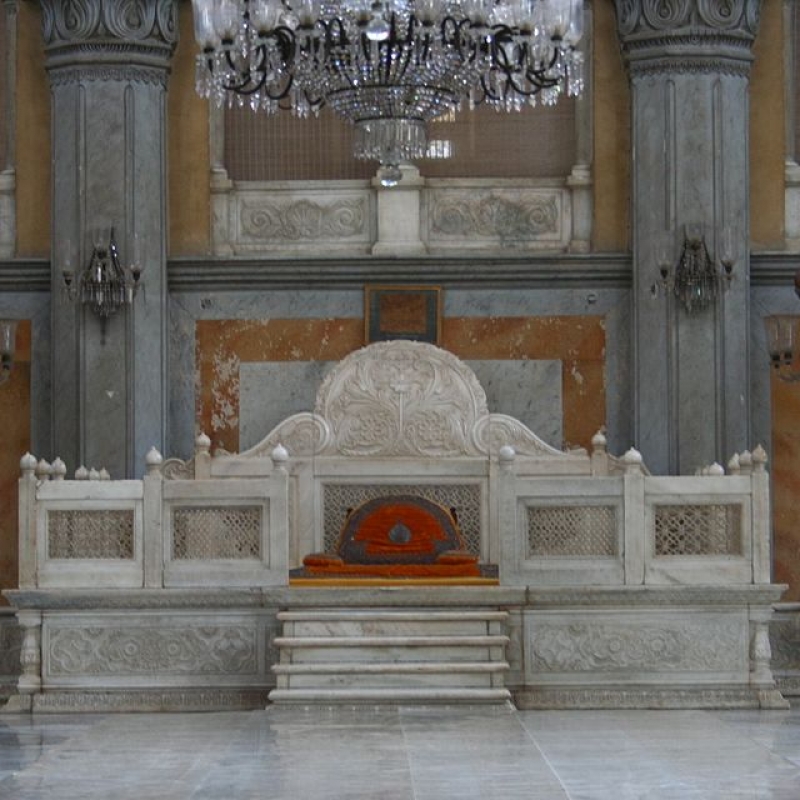While the Targaryens and the Lannisters continue to fight for the coveted Iron Throne in the iconic TV series ‘Game of Thrones’, we look at some of the historic Indian thrones that were symbols of power and wealth.
While many might think that there is no other throne as powerful and coveted as the Iron Throne at King’s Landing, the flick of pages through history books might present some worthy contenders. Much like the fictional world created by George R.R. Martin in the TV series Game of Thrones, the Indian subcontinent has been witness to the rise and fall of several kingdoms and the extravagant show of wealth by its emperors. These rulers, from the Mughals to the Nizams, not only built grand palaces and forts, but also occupied seats of power amid sinister conspiracies, murders and wars. These coveted thrones were made of gold, encrusted with countless precious stones, and have fascinating histories. Unfortunately, many of them were dismantled after wars were lost or the British took over, but that just adds to their lore. Be it Shah Jahan’s Peacock Throne or Tipu Sultan’s Tiger Throne, we look at some of India’s magnificent thrones.
The Peacock Throne
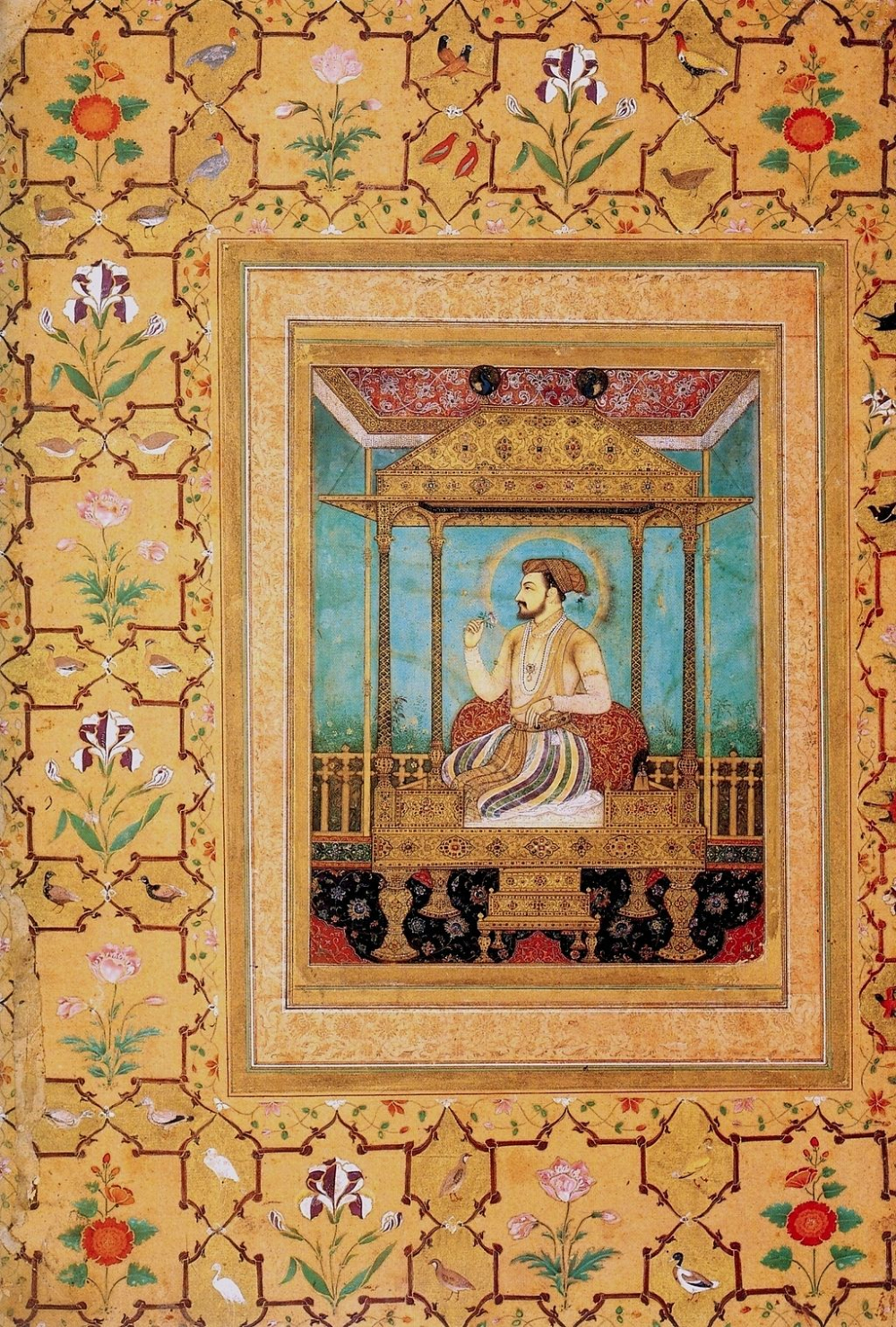
The paintings depicting the famous Peacock Throne are all said to be of its replica, which was made after Nadir Shah took it away (Photo Source: Govardhan/Wikimedia Commons)
Built by the Mughal emperor Shah Jahan (1592–1666), the Peacock Throne was said to have cost him twice as much as the Taj Mahal. According to historical accounts, the throne is believed to have been wrought out of 1150 kg of gold and 230 kg of precious stones, with two open peacock tails made of gold at the back, and was modelled on the Throne of Solomon.[i] The famous Koh-i-Noor diamond was one of the many historical stones to adorn it, along with the world’s second largest spinel ruby (the Timur ruby). A poem by the Mughal poet-laureate Qudsi, in praise of the emperor, was embedded in it in emerald letters.
Shah Jahan ascended to the throne in 1635, only to be usurped by his son in 1658. In 1739, Nadir Shah completed his conquest of Mughal empire by capturing Delhi and took the peacock throne, along with other treasures, to Persia. It is said that it was then dismantled and parts of it incorporated into the Persian Naderi Peacock Throne, now kept in the national treasury of the Central Bank of Iran. Another part is said to be in the Topkapi Palace in Turkey. Interestingly, the paintings depicting the famous Peacock Throne are all said to be of its replica, which was made after Nadir Shah took it away.
The Golden Throne of Mysore
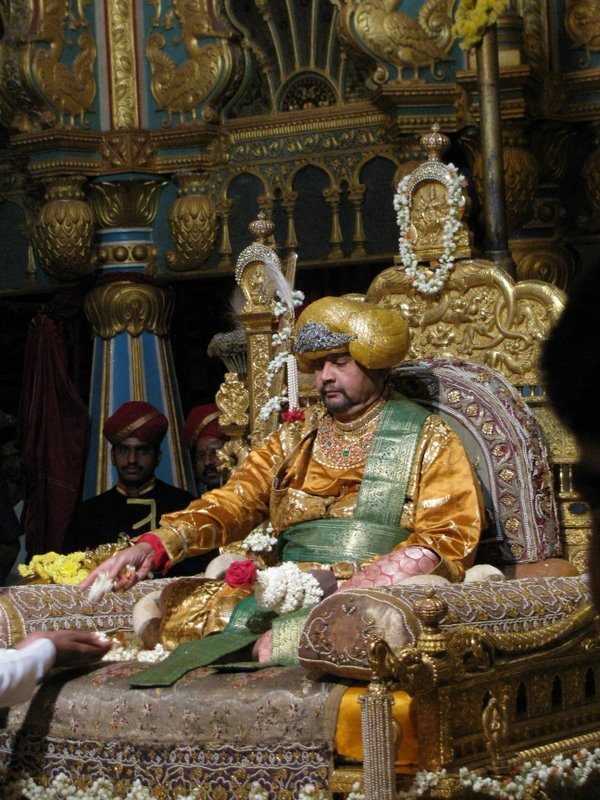
The Golden Throne of Mysore is used for official ceremonies and is open to public viewing during the famous annual Dasara celebrations (Photo Source: Pramukh Arkalgud Ganeshamurthy/Wikimedia Commons )
Currently placed in the Durbar Hall of the Mysore Palace, the Golden Throne was one of the most prized possessions of the Wadiyar dynasty (1399–1950). Made of fig wood, the throne—which is also called Chinnada Simhasana or Ratna Simhasana in Kannada—has ornamental ivory plaques and a golden umbrella. There are various legends associated with the throne. According to one legend, the throne belonged to the Pandavas. It lay buried underground for centuries till it was retrieved by Harihara I, one of the founders of the Vijayanagara empire, in the 14th century. After the fall of the Vijayanagara empire, the throne was passed on from one king to another, till it came to Raja Wadiyar in 1610. Since then, it has been in the Wadiyar family, except for a small interlude in the 18th century.
The iconography on the ornate throne includes ‘half-elephant, half-lion’-shaped armrests, prime goddesses, horses, tigers and swans for victory, the trinity of Brahma-Vishnu-Shiva, the royal emblem of the Mysore kings, Gandaberunda, and shlokas on the umbrella praising Krishnaraja Wadiyar III. Currently, the throne is used for official ceremonies and is open to public viewing during the famous annual Dasara celebrations.
Takht-e-Nishan
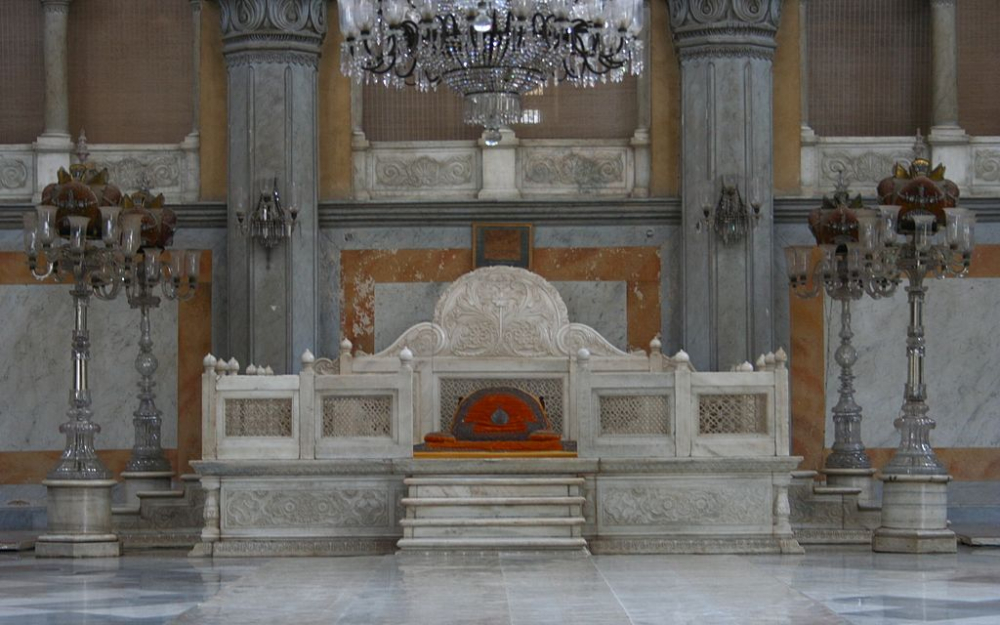
While the Takht-e-Nishan does not have any jewels or gold on it, it is surrounded by 19 awe-inspiring chandeliers made of Belgian crystal (Nagarjun Kandukuru/Wikimedia Commons)
The throne of the Nizams of Hyderabad is still on display at the Durbar Hall (known as Khilwat Mubarak) at the Chowmahalla Palace in Hyderabad. It was once the seat of the Asaf Jahi dynasty (1724–1948). The throne, called the Takht-e-Nishan (simply, royal seat), is a pure marble platform that rests in the heart of the palace. The throne itself exudes power and elegance and while it might not have any jewels or gold on it, it is surrounded by the splendour and opulence of the Nizams, along with 19 awe-inspiring chandeliers of Belgian crystal that hang around it. The Nizams managed to keep their seat of power in Hyderabad at a time when the Mughals ruled much of India, as well as during the British colonial rule thereafter.
Maharaja Ranjit Singh’s Golden Throne
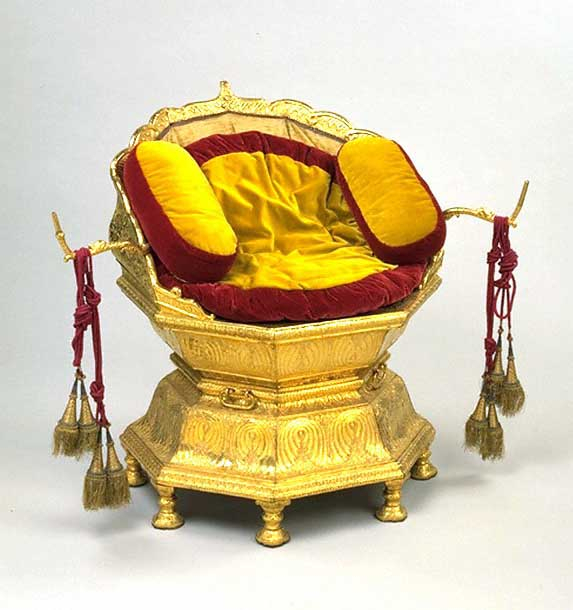
Ranjit Singh was known to be a simple man, who dressed plainly and preferred to sit on a chair or the floor, however, he had a majestic golden throne that he used for state occasions (VA webteam/Wikimedia Commons)
Maharaja Ranjit Singh ruled the Sikh Empire (which included the north-west region of the Indian subcontinent) in the late 18th and early 19th centuries. He was quite a dynamic ruler who courted controversy due to his marriage with a Muslim nautch girl. Part-time owner of the famous Koh-i-Noor diamond and the Timur ruby, Ranjit Singh was known to be a simple man, who dressed plainly and preferred to sit on a chair or the floor. However, he had a majestic golden throne that he used for state occasions. Built by a Muslim goldsmith, Hafez Muhammad Multani, between 1805 and 1810, the octagonal throne was 3-ft tall and almost as wide, covered in a thick gold sheet, and heavily ornamented.
After the East India Company annexed Punjab in 1849, most of the jewels from his treasury were auctioned in Lahore but the throne was retained. The British Governor-General, Lord Dalhousie, in a letter to the Court of Directors of the East India Company in London, wrote, ‘It is set apart as an object which the court would probably desire to preserve.’[ii] Soon thereafter, the throne was sent to London, and is now on display at the Victoria and Albert Museum.
Takht-i-Jahangir
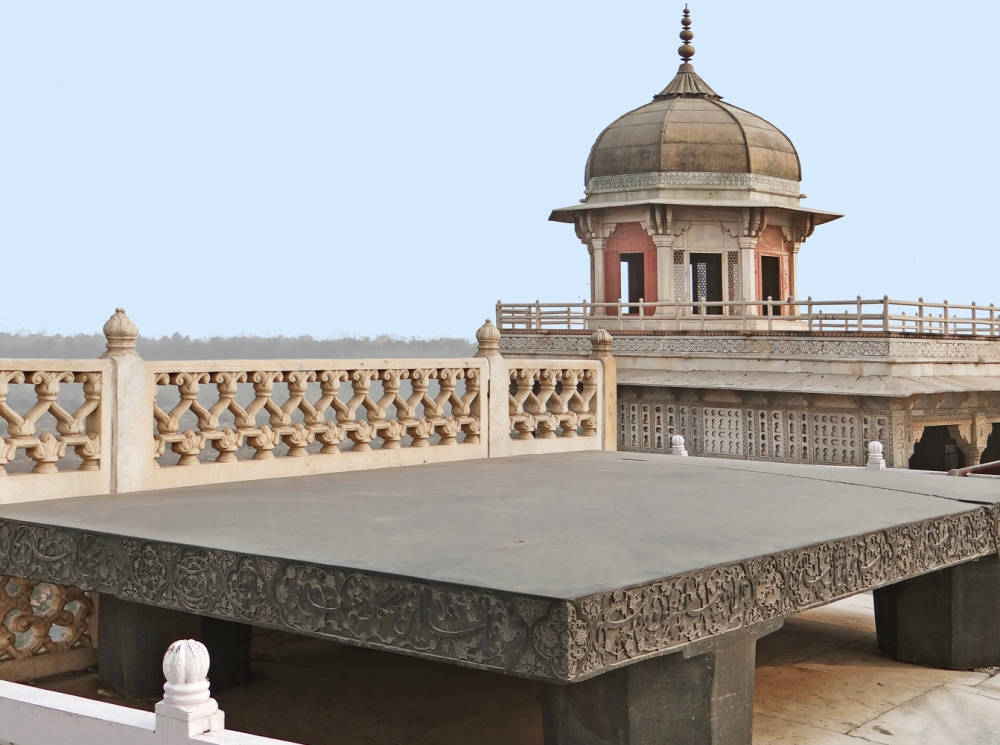
It is said that the Nyay ke Zanjeer (Chains of Truth) with 60 bells would hang behind it and anyone who wanted justice just had to come and ring it (Photo Source: Le Trône de Jahangir/Wikimedia Commons)
Unlike the other ‘regular kingly thrones’ that were sheathed in gold and encrusted with precious stones as a show of the ruler’s wealth and power, Jahangir’s peculiar black throne, called the Takht-i-Jahangir (Throne of Jahangir) is austere and simple. A plain black slab made of touchstone (Sang-i-Mahak, or Kasauti) in Allahabad in 1602, it was 10 feet 7 inches long, 9 feet 10 inches wide and 6 inches thick, sitting on octagonal legs. The throne remained at the Allahabad Fort till 1610, when it was relocated to the Red Fort in Agra after Akbar’s death, where it is placed overlooking the Yamuna river.
There are inscriptions on the side in praise of Jahangir, and it is said that the Nyay ke Zanjeer (Chains of Truth) with 60 bells would hang behind it. Anyone who wanted justice just had to come and ring it.
The Tiger Throne
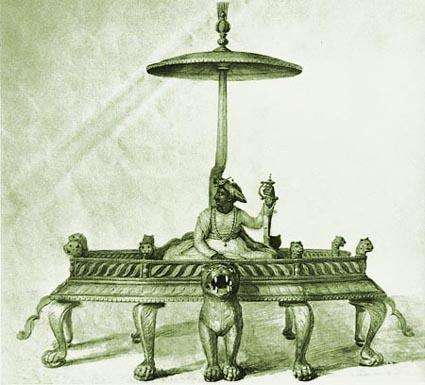
After the siege of Seringapatam in 1799, Tipu Sultan was defeated by the British, and the tiger throne was destroyed and dismantled (Photo Source: chroniclecycles.blogspot.de/Wikimedia Commons)
Tipu Sultan’s gem-crusted octagonal throne is called the ‘Tiger Throne’ after his title, the Tiger of Mysore, and the 10 tiger-head finials on the throne. In History of Tipu Sultan, Mohibbul Hasan Khan wrote that the throne was ‘supported by a wooden tiger, standing erect, covered with gold. It had an octagonal frame, eight feet by five, surrounded by a low railing on which were ten small tiger heads made of gold and beautifully inlaid with precious stones,’ and that ‘it was valued at 1600 guineas (around Rs 1.5 lakh) in India.’[iii]
After the siege of Seringapatam in 1799, Tipu Sultan was defeated by the British, and his treasures were looted by the British soldiers. The Tiger Throne was destroyed and dismantled. In 2009, one of the gem-encrusted golden finials was discovered by Bonhams’ Islamic and Indian Art department on a routine valuation of the Featherstone Castle, Northumberland. It was auctioned for £389,600 (around Rs 3.5 crore) in 2009.
Travancore’s Ivory Throne
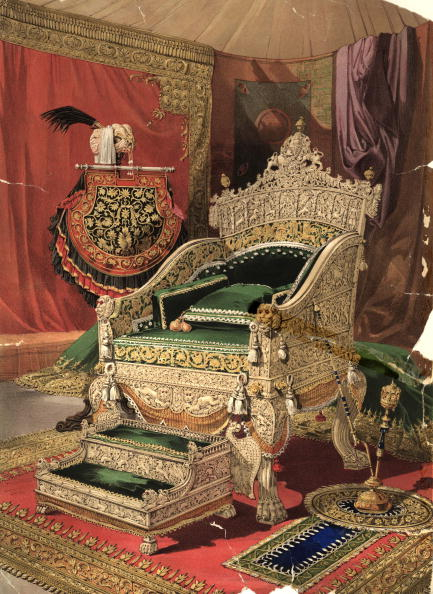
Commissioned in 1849 by Raja Marthanda Varma, the throne was studded with diamonds, emeralds, and rubies (Photo Source: Universal History Archive/Wikimedia Commons)
The house of Travancore was regarded as one of the major centres of ivory-carving in India, so it was befitting that the rulers should sit upon an ivory throne. While this was certainly an object of beauty, the more famous Ivory Throne of Travancore was the one that the rulers barely sat upon. Commissioned in 1849 by Raja Marthanda Varma, the throne was studded with diamonds, emeralds and rubies. The design combined Indian motifs with European designs. The feet were in the form of lion paws and the arms ended with lion heads. A 1903 article on the piece in The Insurance Press further described it, ‘The back is in the form of a shell, supported by elephants, rampant. The seat is of alabaster, and the chair has a gold and silver tissue drapery around the underside… Every outside part of the chair is covered with delicately carved figures of men and animals.’
Interestingly, this throne soon became a political tool and, as Manu S. Pillai, author of The Ivory Throne, wrote in a column, ‘a symbol of Indian princes using gifts to curry favour with the British sovereign’. In 1851, Varma sent it to London as part of the Great Exhibition, which displayed the arts of the British empire, as a gift to Queen Victoria, supposedly in a bid to win the Crown’s favour. There is even an official portrait of the Queen seated in the ‘chair’. The throne has been in the royal collection ever since.[iv]
This article was also published in the print edition of The Statesman.
[i] Swamy, ‘K.R.N., As priceless as the Peacock Throne’, The Tribune, Chandigarh, January 30, 2000, https://www.tribuneindia.com/2000/20000130/spectrum/main7.htm.
[ii] ‘Sikh objects from the V&A Collections’, http://www.vam.ac.uk/content/articles/s/sikh-objects-from-the-collections/.
[iii] Mohibbul Hasan Khan, History of Tipu Sultan (Calcutta: The Bibliophile, Ltd., 1951), 375.
[iv] Pillai, Manu S., ‘Much Ado about a Royal Throne’, Livemint, New Delhi, March 15, 2019,
